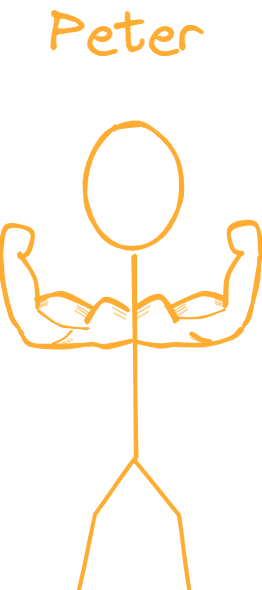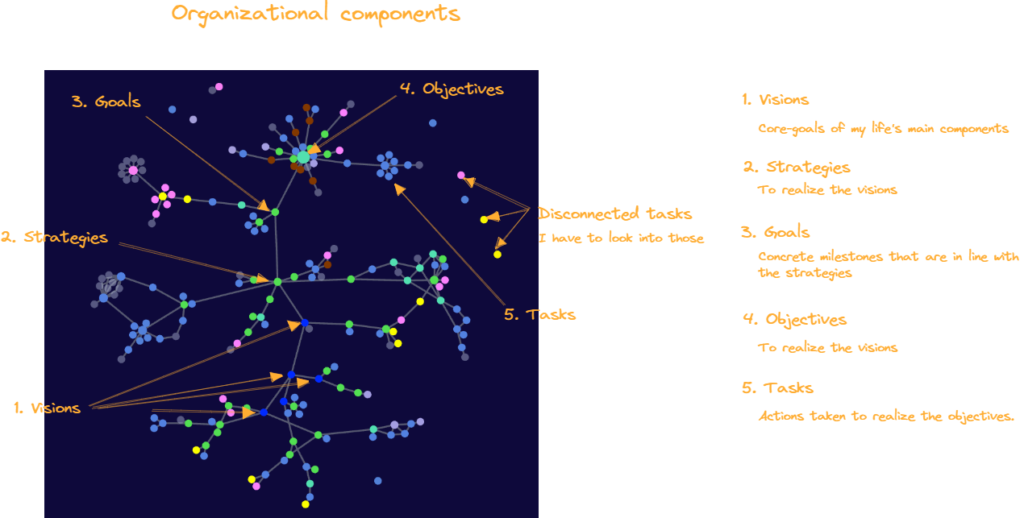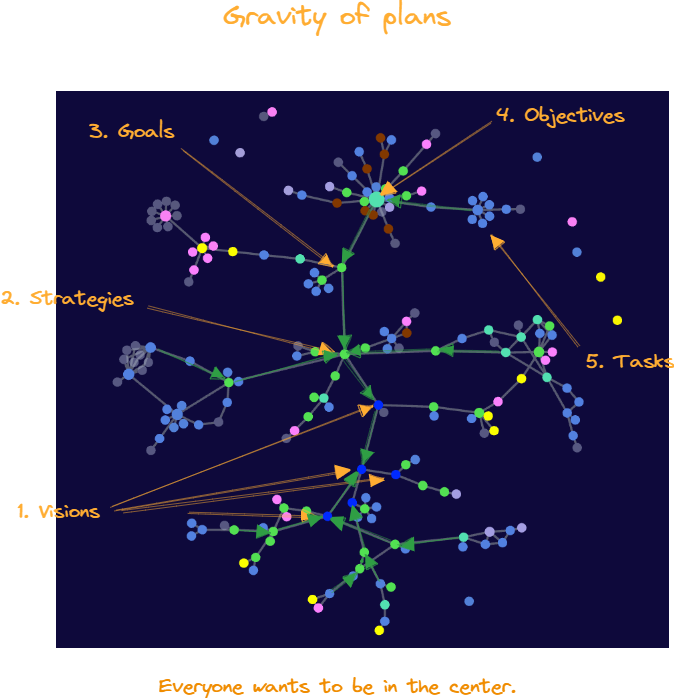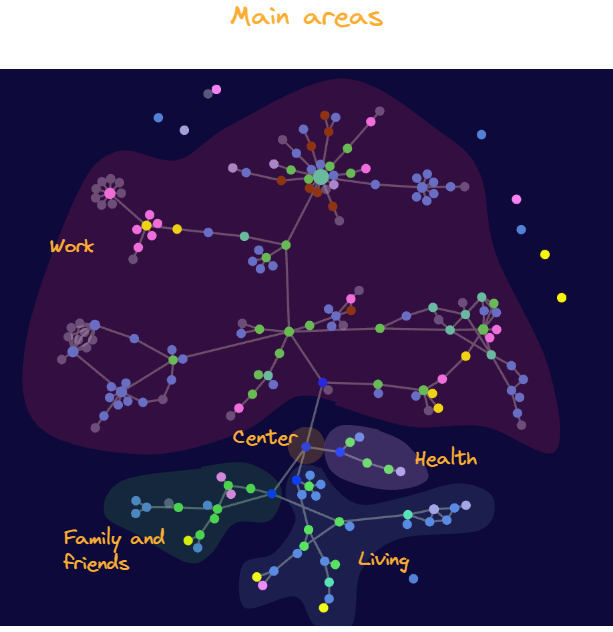Intro
Life is complicated. All the humdrum of growing up, studying, finding a job, personal finance and relationships doesn’t make it easy. Navigating through this maze can feel like searching for a hidden treasure with a malfunctioning GPS. I looked long and hard for ways to make it easier, but neither lists, relational tasks nor any of the other tools that are a project manager’s wet dream could fulfill that need. That was until recently, when I found a tool that visualizes where I am, where I had been, and where I was going. It was like a map showing me more “What If”s than Marvel productions.
So bring your seats in an upright position, fold up your tray-tables and let me take you on this nosy journey into the Map of Life.
What is the map of life
The Map of Life is the superhero blueprint for the greatest project of all; Life. It is a universe of connections that show the relations between tasks, objectives, goals, strategies and visions better than grandma’s family tree.
Like most good things in this world, the Map of Life has its origins in project management. Fiddling around with tasks, their relations, efforts, risks and of course rewards I took more home with me than tiredness and complains. While I was trying to align my wedding-plans with a visit of my parents I realized that it needed a better overview about the upcoming activities. I called upon necessity and like any good mother she guided me towards something that with some fantasy bore a stricken resemblance to the best sci-fi star maps out there.
Set up
So I build the Map of Life Obsidian MD’s graph view. For those unfamiliar with probably one of the best note taking tools currently out there (it pays to take a look), each of those tiny colored circles in the image above is a markdown file.
Think text-file.
The connection between those files is realized through links. When one file A links to file B a connection is created that ties them together with the strength of a hundred Peters, impressively visualized in the graph view.

With the help of tags I created categories of files that for one scratch that organizational itch I, can never fully reach, and two allow me to introduce hierarchy into an otherwise world of equality.

Categories
Following the guidelines of way too enthusiastic MBAs I set out the following categories:
1. Visions
The first and most important part of the map is its goal. Visions are the final and hopefully more pleasant destination where we want to end up in.
They can be abstract and as far fetched as we desire. World domination is as good a candidate to put here as is marriage to that special someone or, like in my case, a small thing like living forever.
2. Strategies
Then come strategies, the buzzword of the 21st century sales-pitch. In the context of the Map of Life they are meant as means to realize the visions. You wanna be financially independent? Then good strategies are A) reduce expenses, B) increase income or C) find that special someone with an extra large and lose purse.
3. Goals
I like to be smart (sometimes managed other times missed beautifully) and what is smarter than SMART goals? Although I rarely manage to check every item on their specific, measurable, attainable, relevant and time-bound list it does feel good to have them. These goals are in line with the strategies and I like to keep them manageable within a 3 month time-period. Looking at the list of manuscripts in my drawer that last part is more a guideline than an actual rule.
4. Objectives
Next come objectives, that synonym we like to dust of when we overuse “goal”. For the map of life, I just use them as sub-goals that are even more specific than goals.
5. Tasks
Tasks make the end of the chain and are the specific actions taken to achieve the objectives.
Example
- Vision: Financial independence
- Strategy: Increase cashflow
- Goal: Find a job that pays 25% more
- Objective: Apply for position at “Mega awesome well paying company”
- Task: Update resume ⇒ Write cover letter ⇒ Take new head-shot ⇒ Send in application
Gravity of plans
The way the hierarchies work and the links are set up, a gravity of sorts forms. Like all gravity it is directed towards the center of the map or its visions.

Benefits
When I created my first map of life, I was primarily feeling the joy of a child that gets to build something colorful. Only later I felt some of its other benefits.
Motivation
Most of all, it is a tool of motivation. Every time I open up the Map of Life it guides me towards success with a shining light. Thanks to it I always know why I am doing a chore. That late night excel file or additional run around the lake never saw what hit them. When we not only know in the back of our minds that it is good to do something, but have the impact and reward written in front of us, the trickle of motivation we normally experience can turn into a raging current.
It also works when I am normally too tired to get anything productive done. You know those late hours, after dinner when you had too much too eat and your lizard brain tells you to curl up in some comfy spot and concentrate on digesting, perhaps with a pinch of sleep thrown in?
The map of life has turned that time into another potential (we all need downtime) activity-block for me. It lowers the obstacle to start work down to a level that even my lazy ass can get up and take it.
And it is damn lazy.
Goal-Reaching
Then, it improves my goal-reaching as reliable as our Chief Paw Officer finds another unsecured sock to rip holes into – with boundless enthusiasm, a wagging tail, and a frighteningly accurate nose. It helps me stay on course and focus on what is important.
No mom, the garbage has to wait right now!
In The Power of Documentation – An Overview I praised documentation like a critique who found his next Michelin star experience. The truth is that my Map of Life deserves a large amount of those laurels. It helped me determine which tasks are important based on the goals they were working towards.
Identifying importance
The Map of Life also visualizes synergy effects. Suddenly it might make sense to clean up the yard, because not only will it brighten my spouse’s day like a 1000 suns, but also clear the path for construction.
In “The One Thing” Papasan and Kelle write about the importance of knowing what task is the most important to concentrate on [Papasan 2012]. They spent a whole book on how to identify and work with it. The Map of Life reduces that task to a simple look.
A small glance is often enough to identify the most important task to concentrate on to realize my visions.
Review
Life-visions are often blurrier than an English morning. As we grow and learn more about the world and ourselves they evolve and change. The same applies to all the strategies, goals, objectives and tasks. Perhaps we realize that a way to pursue a goal isn’t working as intended; and the Map of Life is perfect to see these dead-ends before we reach angry pen-throwing levels of frustration.
Since we see the visions and ways to reach them every time we look at the map, there is a natural review process that enables continuous improvement.
Decision-Making
In that way, the Map of Life improves our decision making.
As an example: Last year after setting up the map I saw my job didn’t bring me forward towards any of my visions. In fact, it kept me from it better than a bridge-troll by stealing valuable time.
Self-Knowing
And the Map of Life helps in identifying the areas of life. It helped me realizing what is important to me in way no self-realization workshop could have done. It also shows me right now that my focus is pretty heavy on the work part which on its own is a good feed back for the whole work-life balance thingy. Who knows what your Map of Life will tell you?

How to
As written earlier, I use Obsidian MD to create the Map of Life shown above, but that doesn’t mean the map is exclusive to it. Any tool that allows an at least 2 dimensional and modifiable visualization will do.
Paper would work just as well as OneNote or any of the other similar note taking tools and flow charts. Also keep in mind Excel can be used for anything.
The comfort of backlinks and automatic connections is a factor though that I would take into account in your choice.
Using obsidian, the files should only link to other files higher up the category-chain of visions, strategies, goals, objectives and tasks. “Should”, because it again only a guideline not a stringent rule that the success of the Map of Life is build on.
In the center of the map is the central core vision, happiness. It is again not a necessity but eases working with the graph due to the inner workings of the engine. Around the core vision I assembled my life-visions:
- Financial independence (meaning: don’t worry about money)
- Living forever (meaning: be healthy)
- Have a happy family and good friends
Next, you set strategies you want to use to pursue the visions. Then follow the goals and then the tasks, all connected through linking to the next file.
The further away from core you move, the more concrete the plans and actions become and the more they are specific to your life.
Anyone can be happy, but only you know what it means for you.
Outro
Like any tool the Map of Life has its limits. For example, there is no easy visualization of time dependencies possible in the way I set up the map within Obsidian. Still, it opened up a whole new way of task management for me and I know it can achieve similar results for you.
Sources
| Key | Citation |
|---|---|
| Papasan 2012 | Papasan, J., & Keller, G. (2012). The One Thing. Bard Press, Austin, Texas. |


Leave a Reply